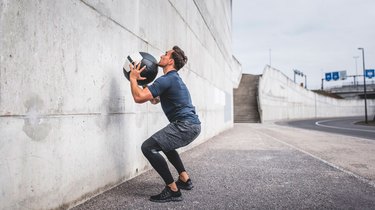
When it feels like there are never enough hours in the day, you want to maximize your workout time. And by "maximize," we don't mean exercise as much as possible. Rather, you're going to want to make the most of the time you're already putting in.
Full-body strength workouts are one of the best ways to do this. Rather than divide your regimen into back-and-biceps days, chest-and-triceps days and legs-and-shoulders days, you hit everything at once. Instead of six sessions per week, you end up with two or three.
Benefits of Full-Body Strength Training
But efficiency is just one of the perks of a total-body strength-training approach. Practicality is another.
"It's movement-specific versus muscle-specific," which makes full-body training more useful in everyday life, says Steve Stonehouse, a National Academy of Sports Medicine-certified personal trainer and director of education at Stride, a chain of indoor running studios in California and Florida.
To explain the difference, think about a sled push and a biceps curl. It's a lot easier to connect pushing a heavy sled to movements someone might do outside the gym, like playing football or working in construction, Stonehouse says. But it's much harder to imagine a job or a sport where the muscle-isolating curl is as relevant, he says.
Full-body training also reduces injury risk, says Wayne Westcott, PhD, professor of exercise science at Quincy College. He recommends balanced training of all the big muscle groups to avoid any weak links. "If you have a major muscle that is not strong and you're an active person, that's the one that's going to be injured," he says.
Building a Full-Body Strength Workout
Full-body training is, in Westcott's words, "any protocol that addresses most, if not all, of the major muscle groups in a single session."
In designing such a routine, he follows the American College of Sports Medicine's resistance exercise recommendations:
- Two to three full-body strength workouts per week
- 2 to 3 sets per exercise
- 8 to 12 reps per set
- Approximately 2 minutes of rest between sets
Tip
It takes your body about two minutes to replenish the energy you use in a set. Waiting that amount of time between sets ensures you’ve “recovered enough so that your second set is a little more meaningful," Westcott says.
As for the exercises themselves, if you have time, Westcott suggests doing one for each of these muscle groups:
- Quads
- Hamstrings
- Abs
- Lower back
- Chest
- Upper back
- Shoulders
- Biceps
- Triceps
If your time is limited (and whose isn't?), you can consolidate. Westcott actually studied abbreviated full-body workouts within the U.S. Navy, which wanted a routine for shipboard members, hard-pressed for space and time. A workout whittled to five exercises still increased strength compared to lengthier routines, he discovered. The key was incorporating exercises that targeted multiple muscle groups.
Try This Full-Body Strength Workout You Can Do Anywhere
Grab a set of dumbbells and a kettlebell and you've got all you need for this workout from Stonehouse, a kettlebell master instructor who teaches certification classes to other trainers. He likes kettlebells for all-around strength-building because they tend to "require a lot of full-body involvement," he says.
Do: 3 sets of 8 to 12 reps per exercise. Rest 2 minutes between sets.
Move 1: Dumbbell Thruster
- Stand with feet shoulder-width apart.
- Hold two dumbbells at your shoulders, palms facing each other.
- Lower yourself into a squat, with thighs parallel to the floor.
- Press through your heels to stand up as you extend your arms to thrust the dumbbells above your head.
Move 2: Kettlebell Swing
- Start standing with your feet at shoulder-width apart, knees bent slightly, gripping a kettlebell on the ground between your feet.
- Keeping your back flat, shoot your hips back and pull the weight between your legs and under your hips.
- On an exhale, push your hips forward and straighten your legs, swinging the bell up to chest height with control.
- Using the bell's momentum, swing the weight back between your legs and under your hips as you simultaneously sink into your hips and bend your knees.
- Push your hips forward again to go right back into the next swing.
Move 3: Turkish Get-Up
- Lie on the ground, facing upward. Bend your right leg so that your foot rests flat on the floor. Your left leg should be straight.
- Hold a kettlebell in your right hand with your arm extended above your chest. Your left arm should be stretched out alongside your body, palm down.
- Raise your right shoulder, pressing the kettlebell skyward, and come up onto your left elbow.
- Push the kettlebell even higher as you shift your body weight from the left elbow to the left hand. You’re now in a fully seated position, braced by your left hand.
- Lift your glutes and extend your hips to straighten your trunk and left leg. You're now in a plank position, balanced on your left hand.
- Bring your left leg back to kneel on your left knee.
- Stand up, keeping the kettlebell raised overhead.
- Reverse the steps to return to the starting position.
- Repeat on the opposite side, with the kettlebell in your left hand.
Tip
Use a light weight if you're new to the Turkish get-up so you can focus on nailing the form first.
Move 4: Wall Ball

- Hold a 15-to-20-pound medicine ball (or another heavy, durable object) in front of you.
- Squat until your thighs are parallel with the ground, holding the ball at your chest.
- As you come up, throw the ball at a target spot on the wall, roughly 11 to 13 feet above you.
No Weights? No Problem!
Build a full-body strength-training workout you can do anywhere using these 18 effective body-weight exercises — no equipment necessary.
Try This Full-Body Strength Workout at the Gym
If you access to gym equipment, give this five-move routine a go. Westcott modeled it after the plan he devised for the Navy.
Do: 3 sets of 8 to 12 reps per exercise. Rest 2 minutes between sets.
Move 1: Bench Press
- Lie on your back on a flat bench.
- Grip a barbell with your hands slightly wider than shoulder-width apart.
- Lower the barbell to just above your chest.
- Lift the barbell until your arms are fully extended. Avoid locking your elbows.
Move 2: Seated Cable Row
- Place your feet on the support plates and hold the cable attachment with your arms outstretched.
- Keeping your back straight and chest up, pull the attachment toward your core.
- Squeeze your shoulder blades together, maintaining the contraction for one to two seconds.
- Extend your arms to return to the starting position.
Move 3: Leg Press
- Seated on a leg press machine, place your feet shoulder-width apart on the platform in front of you.
- Unlatch the safeties at your sides as you extend your legs.
- Retract your legs until they form a 90-degree angle.
- Pushing through your heels, extend your legs without locking your knees.
- Relatch the safeties.
Move 4: Back Extension
- Place the front of your thighs on an exercise ball or on a back extension machine's upper pads, and brace your heels against its lower pads. Your torso should extend diagonally into the air, spine straight.
- With your hands behind your head or your arms crossed over your chest, slowly bend at the hips.
- Continue lowering yourself until your torso forms a 90-degree angle with your legs.
- Lift your torso back to the starting position as you exhale.
Move 5: Machine Seated Crunch
- Sit on an ab crunch machine and grip the handles. If the machine has padded rollers, place the bottom of your shins behind them. If it doesn't, set your feet flat on the floor. Your knees should form a 90-degree angle. (Adjust the seat height as needed.)
- With your chin slightly tucked, pull forward to engage your core.
- Slowly return to the starting position as you inhale.
More Full-Body Strength Workouts We Love